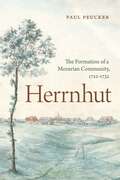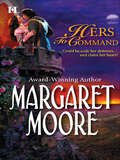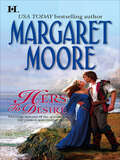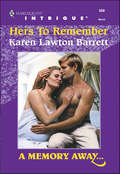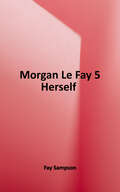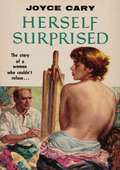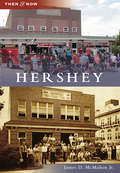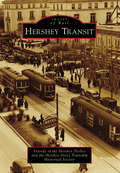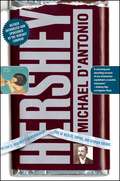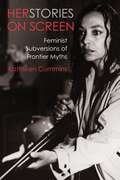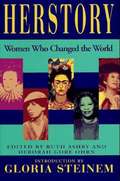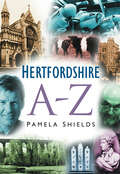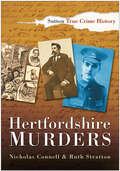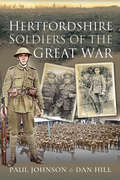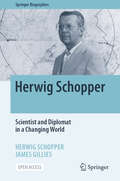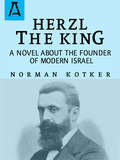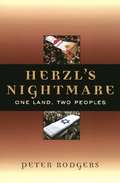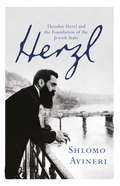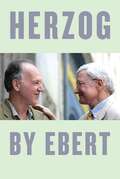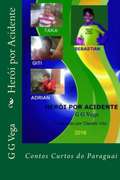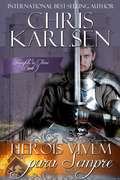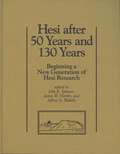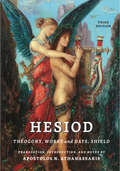- Table View
- List View
Herrnhut: The Formation of a Moravian Community, 1722–1732 (Pietist, Moravian, and Anabaptist Studies)
by Paul PeuckerIn June 1722, three families from Moravia settled on the estate of Count Nikolaus Ludwig von Zinzendorf in Berthelsdorf, Saxony. Known as the community of Herrnhut, their settlement quickly grew to become the epicenter of a transatlantic religious movement, one that would attract thousands of Europeans, American Indians, and enslaved Africans: the Moravian Church.Written by one of the leading archivists of the Moravian Church, this book investigates the origins of Herrnhut. Paul Peucker argues that Herrnhut was intended to be a Philadelphian community, uniting "true Christians" from all denominations. It was a separatist movement, but it concealed its separatism behind the pretense of an affiliation with the Lutheran Church and behind a chosen historical identity, that of the renewed Unity of Brethren. Peucker’s analysis, based on hundreds of documents from archives in Germany and the United States, demonstrates how Herrnhut was able to grow and thrive despite existing regulations against new religious groups, uncovers Count Zinzendorf’s role in keeping Herrnhut outside the state church, and provides a new foundation from which to interpret the Moravian church’s later years.Three centuries after Herrnhut’s founding, this intriguing history brings to light new information about the early years of the Moravian church. Peucker’s work will be especially valuable to students and scholars of eighteenth-century religion, Pietism, and Moravian history.
Herrnhut: The Formation of a Moravian Community, 1722–1732 (Pietist, Moravian, and Anabaptist Studies)
by Paul PeuckerIn June 1722, three families from Moravia settled on the estate of Count Nikolaus Ludwig von Zinzendorf in Berthelsdorf, Saxony. Known as the community of Herrnhut, their settlement quickly grew to become the epicenter of a transatlantic religious movement, one that would attract thousands of Europeans, American Indians, and enslaved Africans: the Moravian Church.Written by one of the leading archivists of the Moravian Church, this book investigates the origins of Herrnhut. Paul Peucker argues that Herrnhut was intended to be a Philadelphian community, uniting “true Christians” from all denominations. It was a separatist movement, but it concealed its separatism behind the pretense of an affiliation with the Lutheran Church and behind a chosen historical identity, that of the renewed Unity of Brethren. Peucker’s analysis, based on hundreds of documents from archives in Germany and the United States, demonstrates how Herrnhut was able to grow and thrive despite existing regulations against new religious groups, uncovers Count Zinzendorf’s role in keeping Herrnhut outside the state church, and provides a new foundation from which to interpret the Moravian church’s later years.Three centuries after Herrnhut’s founding, this intriguing history brings to light new information about the early years of the Moravian church. Peucker’s work will be especially valuable to students and scholars of eighteenth-century religion, Pietism, and Moravian history.
Hers To Command
by Margaret MooreA young noblewoman begs a knight to protect her land but she cannot protect her heart from him in this medieval romance by a USA Today bestseller.Sir Henry was a knight-errant, capable of impressive prowess on the battlefield . . . and in bed. Finding two sisters—one stunningly beautiful, the other steadfast and determined—waiting patiently in his chamber, he entertained their proposition: a generous sum in exchange for commanding their men-at-arms in a battle to save their land.Seduced by the beauty of Gisele, yet irresistibly drawn to the intelligence of Mathilde, a proud woman as complex as her secrets, Henry accepts their offer. But as invaders close in, it is Mathilde who must dare to trust her deepest desires—and the man willing to fight for all he is worth to prove his honor.Praise for Hers to Command“Touching . . . Colorful and compelling details of life in the Middle Ages, from battle strategies to food, abound.” —Publishers Weekly
Hers To Desire
by Margaret MooreA troubled knight longs for the daughter of a traitorous nobleman in this medieval romance by the USA Today–bestselling author of Hers to Command.From the moment they met, Lady Beatrice yearned for the cynical Sir Ranulf. But as the daughter of a traitorous nobleman, she was tainted—marriage was nigh impossible. With little hope of securing the man of her dreams for a lifetime, perhaps the clever young maiden could get her knight for one passionate night. . . . Ranulf never believed he’d ever love a woman well enough to wed—until he met the vivacious Bea.A jaded knight with neither power nor wealth had little to offer a noble lady. Sent by his liege lord to take command of a castle in Cornwall, Ranulf was surprised beyond belief when the virtuous Bea suddenly arrived, intent on seduction. Would desire or honor triumph in this game of love?Praise for Hers to Desire“Readers continue to ask for ‘Moore.’ Her latest book is a sparkling, dynamic tale of two lonely hearts who find each other despite their pasts and the evil forces surrounding them.” —Maria Ferrer, Romantic Times“Completely captivating from the first page to the last.” —Romance Junkies
Hers To Remember (A Memory Away . . .)
by Karen Lawton BarrettShe'd forgotten her past and found her futureWhen Adrienne Winston woke up in the hospital, she found she was missing the past three years of her life. Married and pregnant, Adrienne was forced to trust Sam Donnelly, the stranger who was her husband. While she didn't remember his face, her body recognized his touch and memories of their shared passion lingered. But Adrienne was a woman in trouble. She had the evidence to put a man in jail...and no idea where she had hidden it. She needed Sam's help to uncover her past before it caught up with her-and destroyed the family she wanted desperately to remember.
Herself (Morgan Le Fay #5)
by Fay SampsonI am Morgan the Fay. The wicked witch, the embodiment of evil. And yet. I am the queen who takes Arthur in my arms for healing. Some editing of the story will clearly be necessary. <p><p>Morgan stands by Dozmary Pool after the Battle of Camlann, pleading with the dying Arthur to trust her. Only she can heal him. Is her price too high? As she retraces the bitterness and misunderstanding between them, she throws new light on the tales which the first four narrators have told. But that's not all. There have been countless other versions of her story, from prehistoric myths to contemporary novels. <p><p>With scornful irony Morgan show us how their authors have changed her from a wise and healing ruler to a malignant sorceress and derided temptress. Can Arthur see the truth in time?
Herself Surprised (First Trilogy Ser. #1)
by Joyce CaryHerself Surprised, the first volume of Joyce Cary's remarkable First Trilogy, introduces Sara Monday, a woman at once dissolute and devout, passionate and sly. With no regrets, Sara reviews her changing fortunes, remembering the drudgery of domestic servitude, the pleasures of playing the great lady in a small provincial town, and the splendors and miseries of life as the model, muse, and mistress of the painter Gulley Jimson.
Hershey
by James D. Mcmahon Jr.In 1903, chocolate magnate Milton S. Hershey founded the model town of Hershey, Pennsylvania. Today, the Hershey community remains home to The Hershey Company as well as a number of commercial, educational, and philanthropic institutions that continue to bear the Hershey name.
Hershey Transit
by Hershey Derry Township Historical Society Friends of the Hershey TrolleyWhen Milton S. Hershey broke ground to construct his new chocolate factory in 1903, many questioned the wisdom of building in the middle of a cornfield. With his factory wedged between the Philadelphia & Reading Railroad tracks and the Berks & Dauphin Turnpike, Hershey set out to create a first-rate street railway system. The Hershey Transit Company existed many years after the trolley industry declined in most areas of the United States. It was the chief mode of travel for the chocolate factory workers, vital to dairy farmers for transport of fresh milk to the factory, and essential to students of the Hershey Industrial School housed in surrounding farms. On the weekends, the transit system brought people from outlying areas into Hershey, Pennsylvania, to enjoy the theater or the famous Hershey Park for employee picnics, family outings, or special occasions. Hershey Transit documents one of the best-known and well-kept streetcar systems, started by Milton S. Hershey and operated from 1904 to 1946.
Hershey: Milton S. Hershey's Extraordinary Life of Wealth, Empire, and Utopian Dreams
by Michael D'AntonioExtensively researched and vividly written by Pulitzer Prize–winning journalist Michael D&’Antonio, Hershey is the fascinating story of the unique American visionary Milton S. Hershey.The name Hershey evokes many things: chocolate bars, the company town in Pennsylvania, one of America&’s most recognizable brands. But who was the man behind the name? In this compelling biography, Pulitzer Prize-winning journalist Michael D&’Antonio gives us the real-life rags-to-riches story of Milton S. Hershey, a largely uneducated businessman whose idealistic sense of purpose created an immense financial empire, a town, and a legacy that lasts to this day. Hershey, the son of a minister&’s daughter and an irresponsible father who deserted the family, began his career inauspiciously when the two candy shops he opened both went bankrupt. Undeterred, he started the Lancaster Caramel Company, which brought him success at last. Eventually he sold his caramel operation and went on to perfect the production process of chocolate to create a stable, consistent bar with a long shelf life...and an American icon was born. Hershey was more than a successful businessman—he was a progressive thinker who believed in capitalism as a means to higher goals. He built the world&’s largest chocolate factory and a utopian village for his workers on a large tract of land in rural Pennsylvania, and used his own fortune to keep his workers employed during the Great Depression. In addition, he secretly willed his fortune to a boys&’ school and orphanage, both of which now control a vast endowment.
Herstories on Screen: Feminist Subversions of Frontier Myths
by Professor Kathleen CumminsFrom the late 1970s into the early 1990s, a generation of female filmmakers took aim at their home countries’ popular myths of the frontier. Deeply influenced by second-wave feminism and supported by hard-won access to governmental and institutional funding and training, their trailblazing films challenged traditionally male genres like the Western. Instead of reinforcing the myths of nationhood often portrayed in such films—invariably featuring a lone white male hero pitted against the “savage” and “uncivilized” native terrain—these filmmakers constructed counternarratives centering on women and marginalized communities. In place of rugged cowboys violently removing indigenous peoples to make the frontier safe for their virtuous wives and daughters, these filmmakers told the stories of colonial and postcolonial societies from a female and/or subaltern point of view.Herstories on Screen is a transnational study of feature narrative films from Australia, Canada, the United States, and New Zealand/Aotearoa that deconstruct settler-colonial myths. Kathleen Cummins offers in-depth readings of ten works by a diverse range of women filmmakers including Jane Campion, Julie Dash, Merata Mita, Tracey Moffatt, and Anne Wheeler. She reveals how they skillfully deploy genre tropes and popular storytelling conventions in order to critique master narratives of feminine domesticity and purity and depict women and subaltern people performing acts of agency and resistance. Cummins details the ways in which second-wave feminist theory and aesthetics informed these filmmakers’ efforts to debunk idealized Anglo-Saxon femininity and motherhood and lay bare gendered and sexual violence and colonial oppression.
Herstory: Women Who Changed the World
by Gloria Steinem Ruth Ashby Deborah G. OhrnA very special collection of short biographies offers insightful sketches of the lives and accomplishments of 150 of history's most influential and brilliant women, including Clara Barton, the legendary Trung Sisters of medieval Vietnam, and many others.
Hertfordshire A-Z
by Pamela ShieldsPamela Shields's new book, a compendium of fascinating Hertfordshire facts, is an introduction to the county aimed at residents, visitors and tourists. Home to many 'firsts', such as the English Pope, the Garden City and the New Town, Hertfordshire was also home to many famous people, from King Offa to Laurence Olivier, George Orwell, Graham Greene and Henry Moore - all of whom are featured here. This is where England's crown was surrendered to WIlliam the Conqueror and where a Frenchwoman and a Welshman started the Tudor dynasty. Among the county's geniuses are Sir Geoffrey de Havilland, Sir Jon Sulston and Sir Stephen Hawking. Peculiar survivals such as the Herfordshire Spike and Herfordshire Puddingstone are included, as are urban myths, local legends and much more.
Hertfordshire Murders
by Nicholas Connell Ruth StrattonIn spite of its small size and rural character Hertfordshire has been the location for some of the most infamous and fiendish murders in the history of England. Spanning four centuries, Hertfordshire Murders contains accounts of many of these crimes. Famous cases are re-examined with the help of previously unused archive material and several other major cases are included in a book for the first time.Among the stories are the murder of a reputed witch by an angry village mod and the tale of John Thurtell who short the regency buck William Weare over gambling debts. His execution attracted a crowd of 15,000. Also featured are the accounts of the last man and woman to be executed in Hertfordshire. Supported by dozens of contemporary illustrations, Hertfordshire Murders reveals that behind the county's scenic countryside and rural charm lurks a murky criminal heritage.
Hertfordshire Soldiers of The Great War (Your Towns And Cities In The Great War Ser.)
by Paul Johnson Dan HillCollected first-hand accounts of British men and women serving their country during World War I, as discovered through the Herts At War community project.In Hertfordshire Soldiers of The First World War the authors explore a series of individual case studies of Hertfordshire men who served in various theaters during the First World War, all of which had been uncovered as part of the Herts At War community project. This unique collection of largely unknown accounts includes stories from the Western Front, Gallipoli, Salonika, Mesopotamia, East Africa, Egypt, and even Russia in the fight against the Bolsheviks in 1919.The Herts At War team uncovered many letters and objects in the course of their research, including men who were Victoria Cross winners to those whose courage or bravery went unrecognized, as well as stoicism on the Home Front. One of the most moving of these surrounds a photograph which was found in the hands of Sergeant Percy Buck as he lay fatally wounded in a shell hole in 1917. On the back of the photograph of his wife and young son he had written his address and asked for whoever found the image to post it to his loved ones in the event of his death. Sergeant Buck would have assumed it would be a British comrade who would find the photograph, but the person who recovered it was a German soldier who subsequently sent it on to the grieving, but grateful, family.The war memorials of Hertfordshire contain the names of over 23,000 men and women who gave their lives whilst in the service of their country during the Great War; some of their tales are uncovered here. Indeed, the poignant collection of stories, anecdotes, and artifacts revealed in this book bring the First World War to life in an unusual and highly moving fashion.
Herwig Schopper: Scientist and Diplomat in a Changing World (Springer Biographies)
by James Gillies Herwig SchopperThis open access book is both a memoir and a biography. Born in Czechoslovakia in 1924, Herwig Schopper is one of the few people able to bear witness to 100 years of European history. His career has taken him from research to management to diplomacy, with a major part devoted to, and inspired by, CERN. Herwig enjoyed a rich childhood, spending his summers at his grandparent’s hotel on the Adriatic coast. It is there that he developed an interest in physics though eavesdropping on holidaying professors from Budapest and Belgrade who conversed in German. His youthful idyll was shattered by the annexation of the Sudetenland, which lead to him serving in the Luftwaffe signals corps. Working as a translator for the British administration in Hamburg after the war, he also enrolled at the University and was soon granted leave to travel outside Germany for his research. So began a long string of professional relationships with leading scientists of the day: Lise Meitner, Otto Frisch, Bob Wilson, Chien Shiung Wu, Masatoshi Koshiba and Sam Ting to name but a few. Herwig came to consider them all as friends. Through his long career, Herwig has played a leading role in institutions from Erlangen to Karlsruhe, and from DESY, where he was director from 1973 to 1980, to CERN, where he served as Director-General from 1981 to 1988. Since its foundation CERN has had two major missions: to conduct first-class scientific research and to foster peaceful relations between nations. Following this example Herwig has played a key role in pioneering the deployment of science for peace, notably through the SESAME laboratory in the Middle East. This book gives a full account of Herwig’s rich and varied life and concludes with his reflections on the challenges that society faces today.
Herzl The King: A Novel About the Founder of Modern Israel
by Norman KotkerOn a hill overlooking Jerusalem, the once-mocked Theodor Herzl lies buried in honor as the man who envisioned the modern Jewish state. Neither warrior nor financier, neither theologian nor trained statesman, he was simply a foresighted Viennese journalist who at the beginning of the 20th century brought together from all parts of Europe those Jews able to assess the coming anti-Semitism and join him in the Zionist movement. Like Moses, Herzl led his people to the promised land but did not get to enter it--dying in his forties, alone, and broken by the still-unrealized task. Here is his story.
Herzl the King: A Novel About the Founder of Modern Israel
by Norman KotkerOn a hill overlooking Jerusalem, the once-mocked Theodor Herzl lies buried in honor as the man who envisioned the modern Jewish state. Neither warrior nor financier, neither theologian nor trained statesman, he was simply a foresighted Viennese journalist who at the beginning of the 20th century brought together from all parts of Europe those Jews able to assess the coming anti-Semitism and join him in the Zionist movement. Like Moses, Herzl led his people to the promised land but did not get to enter it -- dying in his forties, alone, and broken by the still-unrealized task. Here is his story.
Herzl's Nightmare: One Land, Two Peoples
by Peter RodgersTheodor Herzl's dream of a national homeland for the Jewish people was realized when Israel declared its independence in 1948. <P><P>Yet it was made possible through the deaths of millions of European Jews and at the expense of Palestinian society--a people who would never forget what they saw as a grave injustice. Herzl's dream would prove illusory. This important new study from the former Australian ambassador to Israel shows how little the dynamics of the conflict have actually changed; how eerily reminiscent today's antagonisms and falsehoods are of yesteryear's; and how much today's self-righteous intransigence--on both sides--owes to what went before.
Herzl: Theodor Herzl and the Foundation of the Jewish State
by Shlomo AvineriThe first biography in more than a generation of the father of modern political Zionism and in effect the state of Israel.Drawing extensively on his diaries as well as his published works, this intellectual biographical follows Herzl's transformation from a private person into the founder and leader of a political movement which made the quest for a Jewish state into a player in international politics. Contrary to the conventional view which saw the Dreyfus affair as the trigger for Herzl's loss of belief in the promise of Jewish emancipation, Avineri shows how it was the political crisis of the Austro-Hungarian Habsburg Empire, torn apart by contending national movements, which convinced Herzl of the need for a Jewish polity.In response to the wide resonance for his 1896 THE JEWISH STATE, Herzl convened the first Zionist Congress in Basel in 1897, which established the World Zionist Organization with its representative and elected institutions; this in turn became the foundation for Israel's democratic political system. In his efforts to gain international support for a Jewish state, Herzl met with the Ottoman Sultan, the German Emperor Wilhelm II, Pope Pius X, British, Russian and German ministers, as well as an enormous number of other government and public opinion leaders of most European countries. By the time of his early death in 1904 at the age of 44, Herzl succeeded in putting Zionism on the map of world politics, no longer an esoteric idea held by a small group of Jewish intellectuals in Eastern Europe.
Herzog by Ebert
by Roger EbertRoger Ebert was the most influential film critic in the United States, the first to win a Pulitzer Prize. For almost fifty years, he wrote with plainspoken eloquence about the films he loved for the Chicago Sun-Times, his vast cinematic knowledge matched by a sheer love of life that bolstered his appreciation of films. Ebert had particular admiration for the work of director Werner Herzog, whom he first encountered at the New York Film Festival in 1968, the start of a long and productive relationship between the filmmaker and the film critic.Herzog by Ebert is a comprehensive collection of Ebert’s writings about the legendary director, featuring all of his reviews of individual films, as well as longer essays he wrote for his Great Movies series. The book also brings together other essays, letters, and interviews, including a letter Ebert wrote Herzog upon learning of the dedication to him of “Encounters at the End of the World;” a multifaceted profile written at the 1982 Cannes Film Festival; and an interview with Herzog at Facet’s Multimedia in 1979 that has previously been available only in a difficult-to-obtain pamphlet. Herzog himself contributes a foreword in which he discusses his relationship with Ebert. Brimming with insights from both filmmaker and film critic, Herzog by Ebert will be essential for fans of either of their prolific bodies of work.
Herói por Acidente
by Guido Galeano Vega Claudio VazNa Comunidade de Chololó, um lugar turístico muito simples e, por isso, pitoresco e atraente na República do Paraguai, entre as serras de Paraguarí e Piribebuy, onde correm águas frescas e cristalinas de belos arroios, entre verdes e frescas vegetações, com ar puro e melodia da natureza, encontra-se uma família numerosa, composta de uma mãe de várias mães, de muitos filhos, filhas e muitos netos e netas.
Heróis Vivem para Sempre
by Tainá Fernandes da Rocha de Araujo Chris KarlsenElinor Hawthorne herdou uma casa assombrada pelos fantasmas de dois cavaleiros medievais, Basil Manneville e Guy Guiscard. Basil é o homem dos seus sonhos, seu cavaleiro de armadura brilhante. Ela se apaixona por ele e, ele por ela. Basil logo se dá conta de que ela precisa viver uma vida normal, um vida feliz com um mortal. Anos se passaram, até que o destino intervém. Basil, ainda apaixonado por Elinor, recebe a notícia de que seu espírito reside em uma jovem mulher e recebe uma nova oportunidade em vida para encontrá-la.
Hesi after 50 Years and 130 Years: Beginning a New Generation of Hesi Research (Joint Archaeological Expedition to Tell el-Hesi)
by John R. Spencer, James W. Hardin, and Jeffrey A. BlakelyTell el-Hesi is located near the modern city of Qiryat Gat in the Southern District of Israel, 23 kilometers from the Mediterranean Sea. The site, which covers 35–40 acres, includes both an acropolis and a lower city. Occupation of the site began as early as the Neolithic period, and the city grew significantly during the Early Bronze Age before being abandoned until the Late Bronze Age. The latest phase of occupation occurred during the Hellenistic period. The acropolis was in use for almost two thousand years. This volume is the first in a new iteration of the Joint Archaeological Expedition to Tell el-Hesi series that builds on previously published volumes. It publishes a final report for part of one of Tell el-Hesi’s excavation fields; a reevaluation of the stratigraphic findings of the original 1891–1892 excavations on Tell el-Hesi, based on excavation work from the 1970s and 1980s; in-depth studies of groups of small finds from the tell; and zooarchaeological analyses that widen the investigative perspective to include the region around the tell.Paying tribute to the long excavation history at Tell el-Hesi, the contributors to this volume employ state-of-the-art scientific methods that honor the careful work and findings of a century of excavations. Hesi After 50 Years and 130 Years will be an important reference for scholars researching the history and culture of southern Palestine.
Hesiod: Theogony, Works and Days, Shield
by Apostolos N. AthanassakisThis best-selling translation of Hesiod's the Theogony, the Works and Days, and the Shield has been updated into the most indispensable edition yet for students of Greek mythology and literature.Next to the works of Homer, Hesiod's poems are foundational texts for students of the classics. His two major surviving works, the Theogony and the Works and Days, address the divine and the mundane, respectively. The Theogony traces the origins of the Greek gods and recounts the events surrounding the crowning of Zeus as their king, while the Works and Days is a manual of moral instruction in verse addressed to farmers and peasants. Though modern scholars dispute the authorship of the Shield, ancient texts treat this final poem about the shield of Herakles as unquestionably Hesiodic.Introducing his celebrated translations of Hesiod, Apostolos N. Athanassakis positions the philosopher-poet as heir to a long tradition of Hellenic poetry. Hesiod's poems demonstrate the author's passionate interest in the governance of human society through justice and a tangible work ethic. As a physicist and a materialist, Hesiod avoided such subjects as honor and the afterlife. His works contain the oldest fundamentals on law and Greek economy, making Hesiod the first great thinker of Western civilization. Athanassakis's contextual notes offer both comparison to Biblical and Norse mythologies as well as anthropological connections to modern Greece.The third edition of this classic undergraduate text includes a thoroughly updated bibliography reflecting the last two decades of scholarship. The introductions and notes have been enriched, clarifying contextual history and the meaning of Hesiod's own language and themes, and notes have been newly added to the Shield. Athanassakis has lightly improved his translation throughout the text, expertly balancing the natural flow of the verse while adhering closely to the literal Greek.
